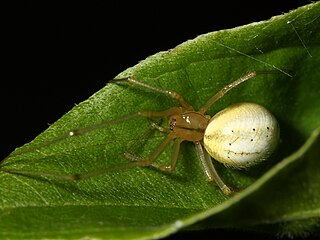
Theridiidae, also known as the tangle-web spiders, cobweb spiders and comb-footed spiders, is a large family of araneomorph spiders first described by Carl Jakob Sundevall in 1833. This diverse, globally distributed family includes over 3,000 species in 124 genera, and is the most common arthropod found in human dwellings throughout the world.

Achaearanea is a genus of comb-footed spiders that was first described by Embrik Strand in 1929.

Episinus is a genus of comb-footed spiders that was first described by Pierre André Latreille in 1809.

Chrysso is a genus of comb-footed spiders that was first described by Octavius Pickard-Cambridge in 1882.

Stemmops is a genus of comb-footed spiders that was first described by Octavius Pickard-Cambridge in 1894.

Chrosiothes is a genus of comb-footed spiders that was first described by Eugène Louis Simon in 1894. It is considered a senior synonym of Theridiotis.
Paratheridula is a monotypic genus of comb-footed spiders containing the single species, Paratheridula perniciosa. The sole species was first described in 1886 under the name Theridion perniciosum. The genus was first described by Herbert Walter Levi in 1957, though it has been described under several different names, including Mysmena 4-maculata, Theridion quadrimaculatum, and Theridion arcadicum,

Cryptachaea is a genus of spiders in the Theridiidae family.

Parasteatoda is a genus of comb-footed spiders that was first described by Allan Frost Archer in 1946. The name is a combination of the Ancient Greek "para-" (παρά), meaning "near" or "next to", and the theridiid genus Steatoda. The Japanese name for this genus is O-himegumo zoku.

Platnickina is a genus of comb-footed spiders that was first described by A. Ö. Koçak & M. Kemal in 2008.
Janula is a genus of comb-footed spiders that was first described by Embrik Strand in 1932. It is a senior synonym of Monetoculus.
Echinotheridion is a genus of comb-footed spiders that was first described by Herbert Walter Levi in 1963.

Hentziectypus is a genus of comb-footed spiders that was first described by Allan Frost Archer in 1946. Originally placed with Theridion, it was moved to Achaearanea in 1955, and to its own genus in 2008. These spiders most resemble members of Cryptachaea, but are distinguished by a median apophysis that is broadly attached to the tegulum. Spiders of Parasteatoda have a median apophysis attached to the embolus, while those of Achaearanea have a hooked paracymbium on the pedipalps of males.
Neopisinus is a genus of comb-footed spiders that was first described by M. A. L. Marques, E. H. Buckup & E. N. L. Rodrigues in 2011.
Okumaella is a monotypic genus of East Asian comb-footed spiders containing the single species, Okumaella okumae. It was first described by H. Yoshida in 2009, and is found in Japan. This genus is named in honour of the Japanese arachnologist Chiyoko Okuma.

Pholcomma is a genus of comb-footed spiders that was first described by Tamerlan Thorell in 1869.

Phycosoma is a genus of comb-footed spiders that was first described by Octavius Pickard-Cambridge in 1880.

Rhomphaea is a genus of comb-footed spiders that was first described by Ludwig Carl Christian Koch in 1872.
Takayus is a genus of Asian comb-footed spiders that was first described by H. Yoshida in 2001.

Yunohamella is a genus of comb-footed spiders that was first described by H. Yoshida in 2007.













